Gender and Touching Research Proposal
VerifiedAdded on 2020/03/01
|11
|2106
|56
AI Summary
This research project proposal investigates the role of gender in nonverbal communication through touching. It aims to identify behavioral patterns in touch interactions between genders, utilizing qualitative methods and surveys to gather data. The proposal outlines objectives, research methods, participant selection, and ethical considerations, emphasizing the significance of understanding how touch varies across genders in social contexts.
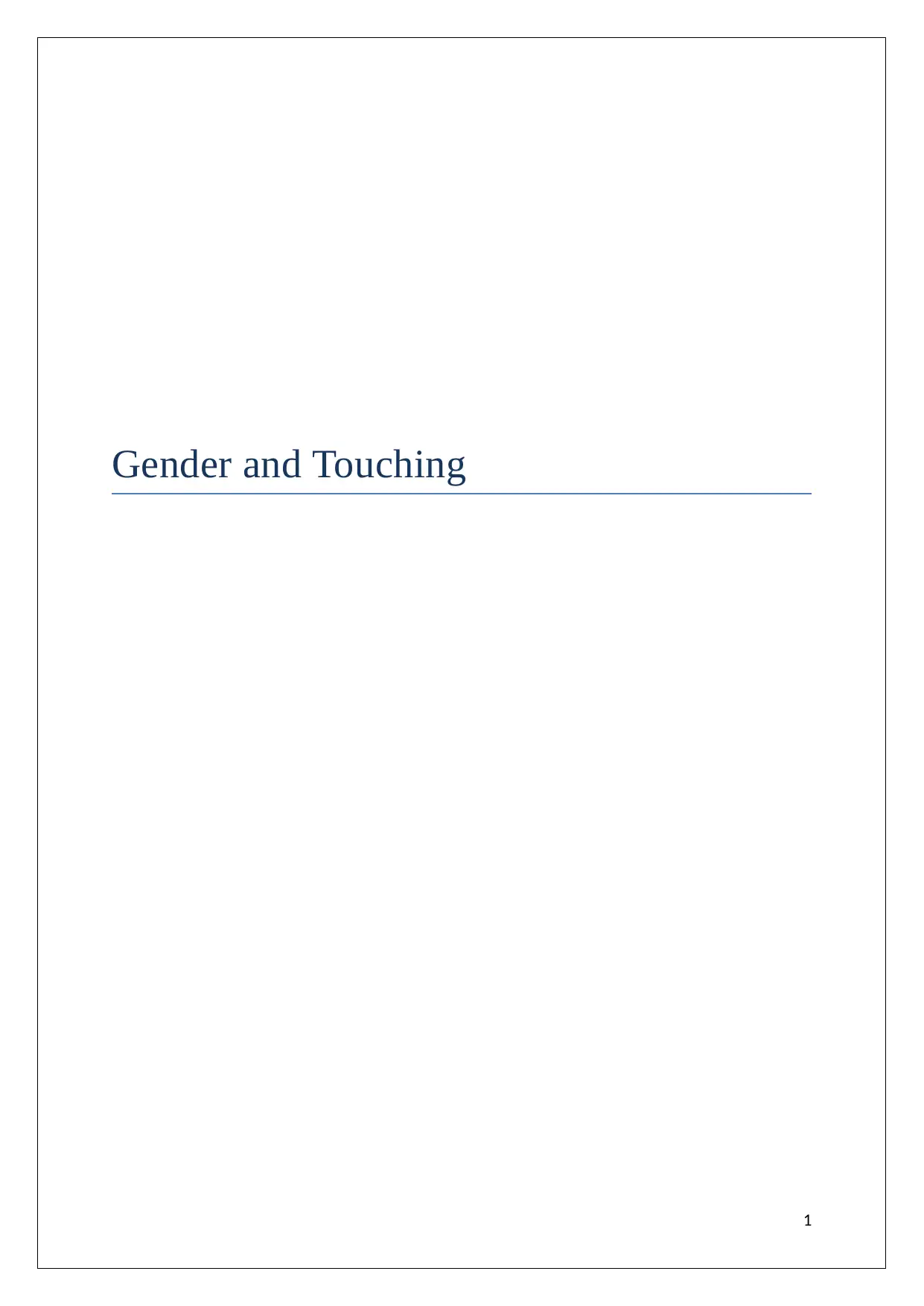
Gender and Touching
1
1
Paraphrase This Document
Need a fresh take? Get an instant paraphrase of this document with our AI Paraphraser
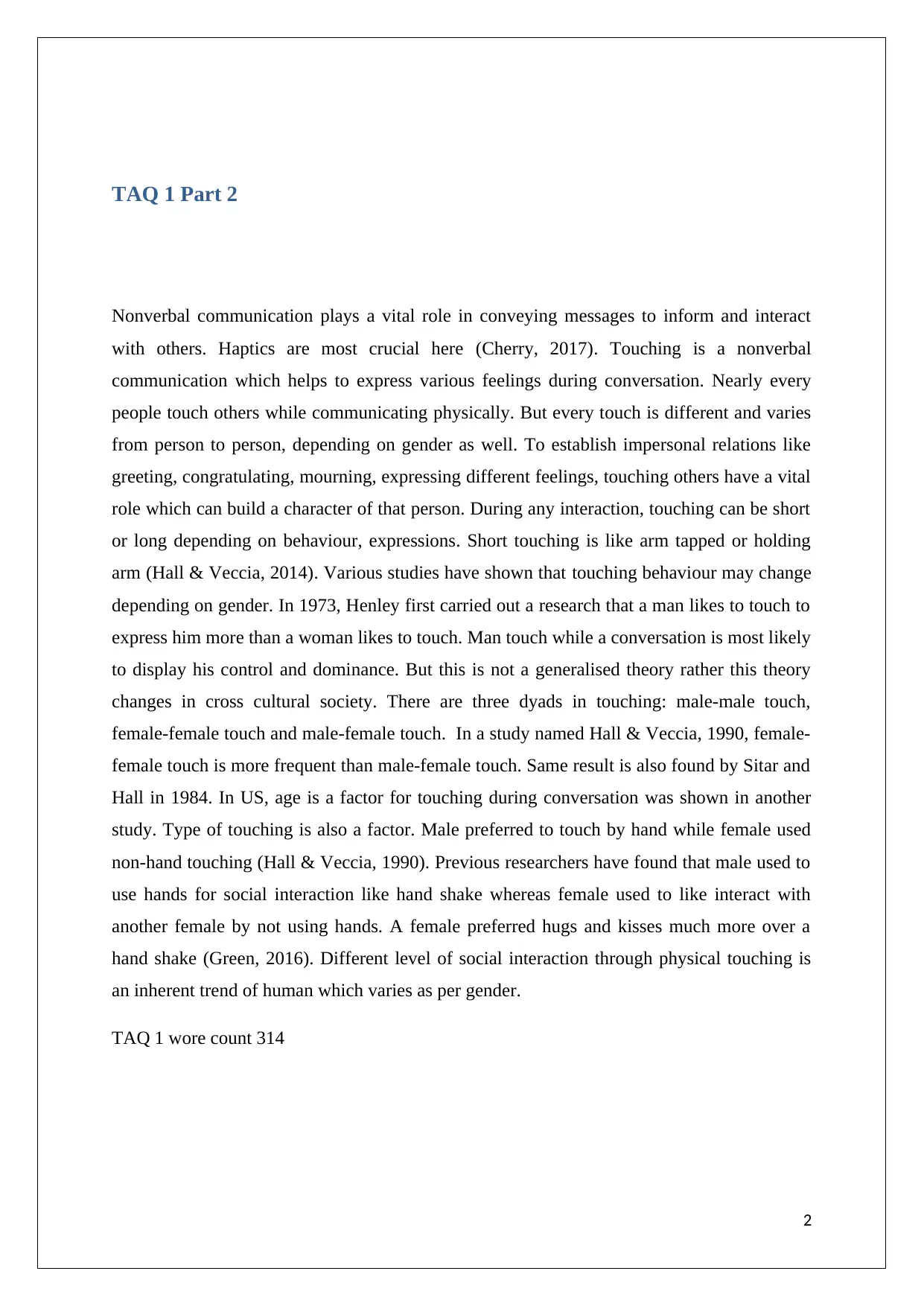
TAQ 1 Part 2
Nonverbal communication plays a vital role in conveying messages to inform and interact
with others. Haptics are most crucial here (Cherry, 2017). Touching is a nonverbal
communication which helps to express various feelings during conversation. Nearly every
people touch others while communicating physically. But every touch is different and varies
from person to person, depending on gender as well. To establish impersonal relations like
greeting, congratulating, mourning, expressing different feelings, touching others have a vital
role which can build a character of that person. During any interaction, touching can be short
or long depending on behaviour, expressions. Short touching is like arm tapped or holding
arm (Hall & Veccia, 2014). Various studies have shown that touching behaviour may change
depending on gender. In 1973, Henley first carried out a research that a man likes to touch to
express him more than a woman likes to touch. Man touch while a conversation is most likely
to display his control and dominance. But this is not a generalised theory rather this theory
changes in cross cultural society. There are three dyads in touching: male-male touch,
female-female touch and male-female touch. In a study named Hall & Veccia, 1990, female-
female touch is more frequent than male-female touch. Same result is also found by Sitar and
Hall in 1984. In US, age is a factor for touching during conversation was shown in another
study. Type of touching is also a factor. Male preferred to touch by hand while female used
non-hand touching (Hall & Veccia, 1990). Previous researchers have found that male used to
use hands for social interaction like hand shake whereas female used to like interact with
another female by not using hands. A female preferred hugs and kisses much more over a
hand shake (Green, 2016). Different level of social interaction through physical touching is
an inherent trend of human which varies as per gender.
TAQ 1 wore count 314
2
Nonverbal communication plays a vital role in conveying messages to inform and interact
with others. Haptics are most crucial here (Cherry, 2017). Touching is a nonverbal
communication which helps to express various feelings during conversation. Nearly every
people touch others while communicating physically. But every touch is different and varies
from person to person, depending on gender as well. To establish impersonal relations like
greeting, congratulating, mourning, expressing different feelings, touching others have a vital
role which can build a character of that person. During any interaction, touching can be short
or long depending on behaviour, expressions. Short touching is like arm tapped or holding
arm (Hall & Veccia, 2014). Various studies have shown that touching behaviour may change
depending on gender. In 1973, Henley first carried out a research that a man likes to touch to
express him more than a woman likes to touch. Man touch while a conversation is most likely
to display his control and dominance. But this is not a generalised theory rather this theory
changes in cross cultural society. There are three dyads in touching: male-male touch,
female-female touch and male-female touch. In a study named Hall & Veccia, 1990, female-
female touch is more frequent than male-female touch. Same result is also found by Sitar and
Hall in 1984. In US, age is a factor for touching during conversation was shown in another
study. Type of touching is also a factor. Male preferred to touch by hand while female used
non-hand touching (Hall & Veccia, 1990). Previous researchers have found that male used to
use hands for social interaction like hand shake whereas female used to like interact with
another female by not using hands. A female preferred hugs and kisses much more over a
hand shake (Green, 2016). Different level of social interaction through physical touching is
an inherent trend of human which varies as per gender.
TAQ 1 wore count 314
2
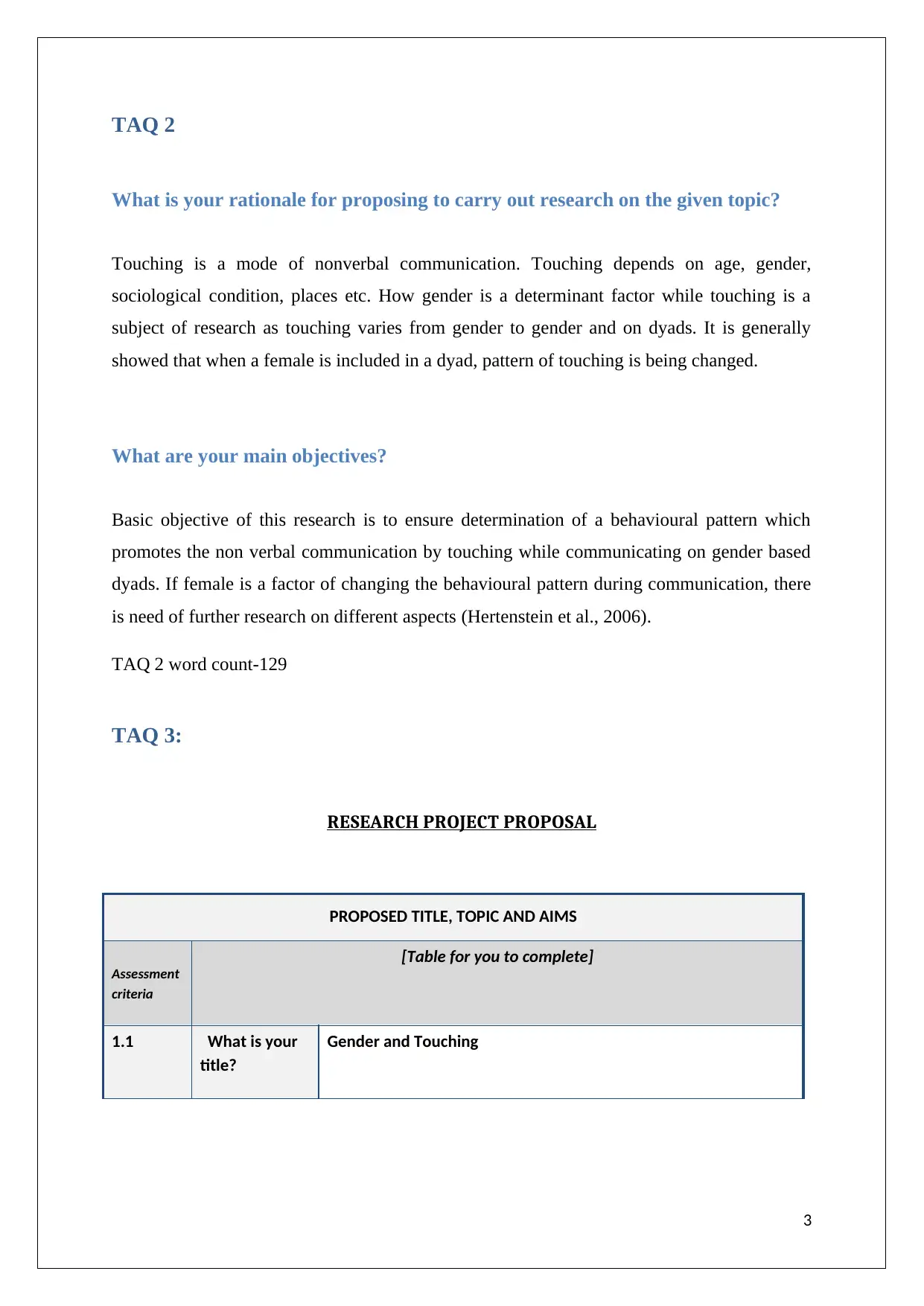
TAQ 2
What is your rationale for proposing to carry out research on the given topic?
Touching is a mode of nonverbal communication. Touching depends on age, gender,
sociological condition, places etc. How gender is a determinant factor while touching is a
subject of research as touching varies from gender to gender and on dyads. It is generally
showed that when a female is included in a dyad, pattern of touching is being changed.
What are your main objectives?
Basic objective of this research is to ensure determination of a behavioural pattern which
promotes the non verbal communication by touching while communicating on gender based
dyads. If female is a factor of changing the behavioural pattern during communication, there
is need of further research on different aspects (Hertenstein et al., 2006).
TAQ 2 word count-129
TAQ 3:
RESEARCH PROJECT PROPOSAL
"PROPOSED TITLE, TOPIC AND AIMS"
"
Assessment
criteria"
"[Table for you to complete]"
1.1 "What is your
title?"
Gender and Touching
3
What is your rationale for proposing to carry out research on the given topic?
Touching is a mode of nonverbal communication. Touching depends on age, gender,
sociological condition, places etc. How gender is a determinant factor while touching is a
subject of research as touching varies from gender to gender and on dyads. It is generally
showed that when a female is included in a dyad, pattern of touching is being changed.
What are your main objectives?
Basic objective of this research is to ensure determination of a behavioural pattern which
promotes the non verbal communication by touching while communicating on gender based
dyads. If female is a factor of changing the behavioural pattern during communication, there
is need of further research on different aspects (Hertenstein et al., 2006).
TAQ 2 word count-129
TAQ 3:
RESEARCH PROJECT PROPOSAL
"PROPOSED TITLE, TOPIC AND AIMS"
"
Assessment
criteria"
"[Table for you to complete]"
1.1 "What is your
title?"
Gender and Touching
3
⊘ This is a preview!⊘
Do you want full access?
Subscribe today to unlock all pages.

Trusted by 1+ million students worldwide
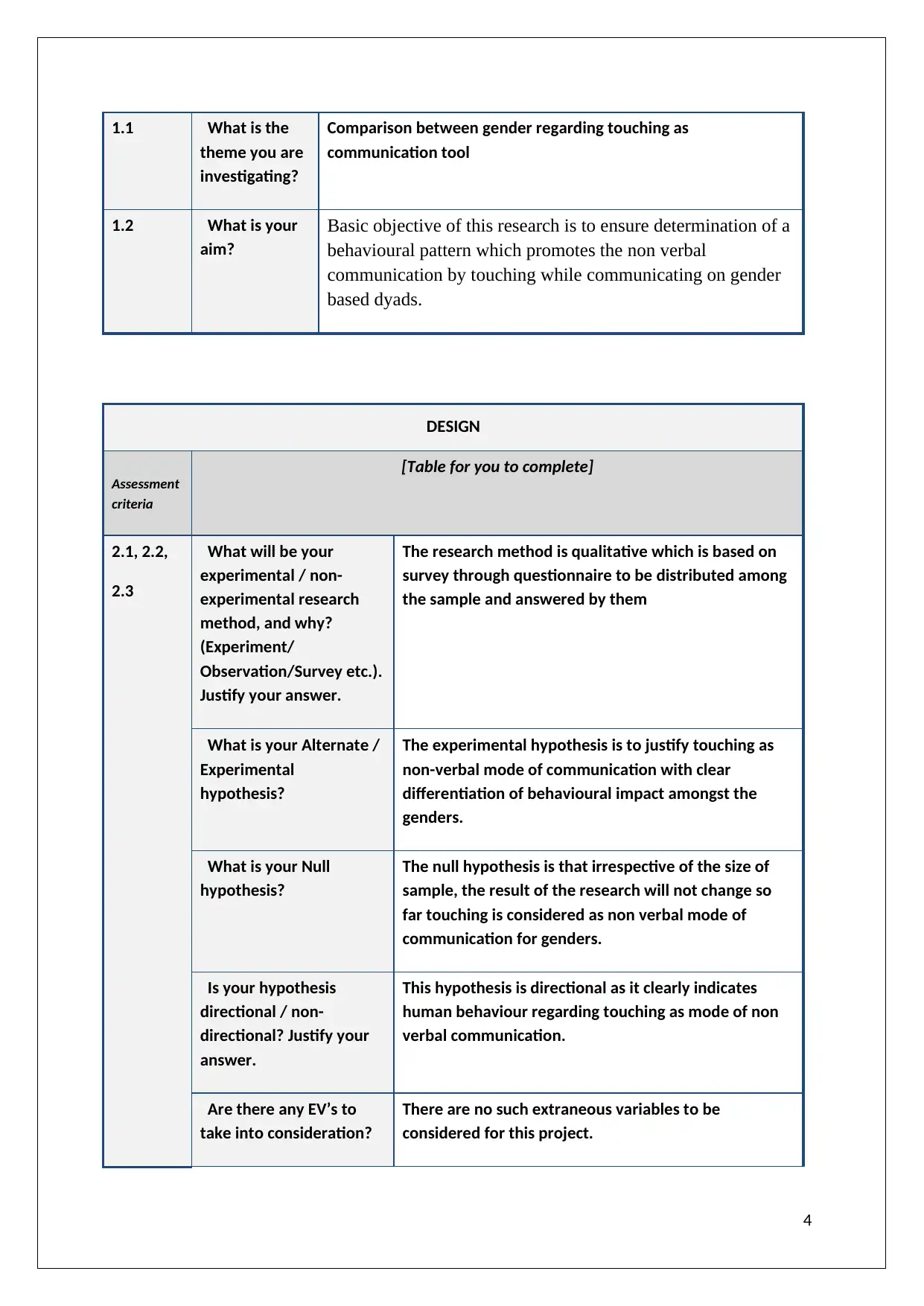
1.1 "What is the
theme you are
investigating?"
Comparison between gender regarding touching as
communication tool
1.2 "What is your
aim?"
Basic objective of this research is to ensure determination of a
behavioural pattern which promotes the non verbal
communication by touching while communicating on gender
based dyads.
"DESIGN"
"
Assessment
criteria"
"[Table for you to complete]"
2.1, 2.2,
2.3
"What will be your
experimental / non-
experimental research
method, and why?
(Experiment/
Observation/Survey etc.).
Justify your answer."
The research method is qualitative which is based on
survey through questionnaire to be distributed among
the sample and answered by them
"What is your Alternate /
Experimental
hypothesis?"
The experimental hypothesis is to justify touching as
non-verbal mode of communication with clear
differentiation of behavioural impact amongst the
genders.
"What is your Null
hypothesis?"
The null hypothesis is that irrespective of the size of
sample, the result of the research will not change so
far touching is considered as non verbal mode of
communication for genders.
"Is your hypothesis
directional / non-
directional? Justify your
answer."
This hypothesis is directional as it clearly indicates
human behaviour regarding touching as mode of non
verbal communication.
"Are there any EV’s to
take into consideration?"
There are no such extraneous variables to be
considered for this project.
4
theme you are
investigating?"
Comparison between gender regarding touching as
communication tool
1.2 "What is your
aim?"
Basic objective of this research is to ensure determination of a
behavioural pattern which promotes the non verbal
communication by touching while communicating on gender
based dyads.
"DESIGN"
"
Assessment
criteria"
"[Table for you to complete]"
2.1, 2.2,
2.3
"What will be your
experimental / non-
experimental research
method, and why?
(Experiment/
Observation/Survey etc.).
Justify your answer."
The research method is qualitative which is based on
survey through questionnaire to be distributed among
the sample and answered by them
"What is your Alternate /
Experimental
hypothesis?"
The experimental hypothesis is to justify touching as
non-verbal mode of communication with clear
differentiation of behavioural impact amongst the
genders.
"What is your Null
hypothesis?"
The null hypothesis is that irrespective of the size of
sample, the result of the research will not change so
far touching is considered as non verbal mode of
communication for genders.
"Is your hypothesis
directional / non-
directional? Justify your
answer."
This hypothesis is directional as it clearly indicates
human behaviour regarding touching as mode of non
verbal communication.
"Are there any EV’s to
take into consideration?"
There are no such extraneous variables to be
considered for this project.
4
Paraphrase This Document
Need a fresh take? Get an instant paraphrase of this document with our AI Paraphraser
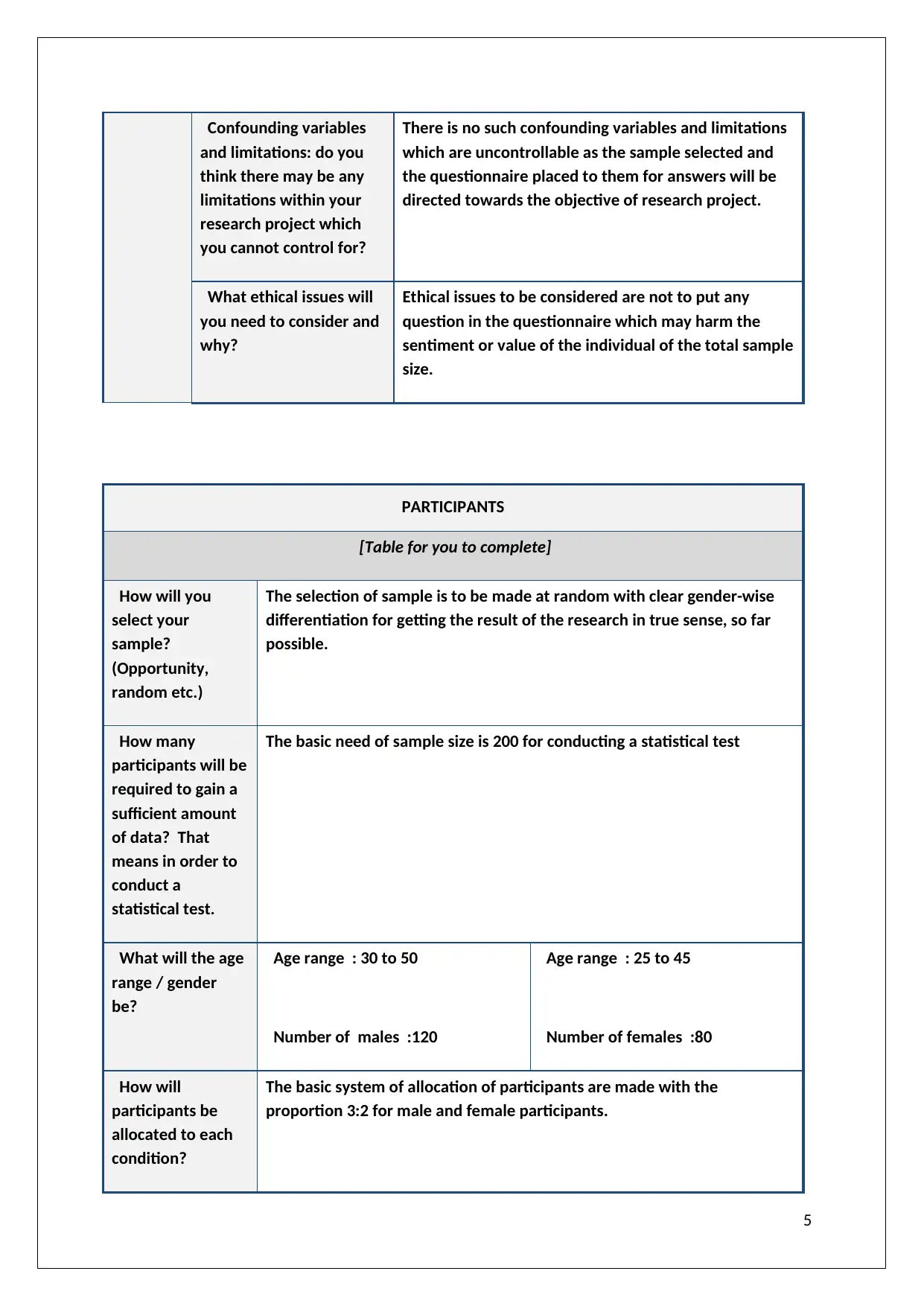
"Confounding variables
and limitations: do you
think there may be any
limitations within your
research project which
you cannot control for?"
There is no such confounding variables and limitations
which are uncontrollable as the sample selected and
the questionnaire placed to them for answers will be
directed towards the objective of research project.
"What ethical issues will
you need to consider and
why?"
Ethical issues to be considered are not to put any
question in the questionnaire which may harm the
sentiment or value of the individual of the total sample
size.
"PARTICIPANTS"
" [Table for you to complete]"
"How will you
select your
sample?
(Opportunity,
random etc.)"
The selection of sample is to be made at random with clear gender-wise
differentiation for getting the result of the research in true sense, so far
possible.
"How many
participants will be
required to gain a
sufficient amount
of data? That
means in order to
conduct a
statistical test."
The basic need of sample size is 200 for conducting a statistical test
"What will the age
range / gender
be?"
"Age range": 30 to 50
"Number of males":120
"Age range": 25 to 45
"Number of females":80
"How will
participants be
allocated to each
condition?"
The basic system of allocation of participants are made with the
proportion 3:2 for male and female participants.
5
and limitations: do you
think there may be any
limitations within your
research project which
you cannot control for?"
There is no such confounding variables and limitations
which are uncontrollable as the sample selected and
the questionnaire placed to them for answers will be
directed towards the objective of research project.
"What ethical issues will
you need to consider and
why?"
Ethical issues to be considered are not to put any
question in the questionnaire which may harm the
sentiment or value of the individual of the total sample
size.
"PARTICIPANTS"
" [Table for you to complete]"
"How will you
select your
sample?
(Opportunity,
random etc.)"
The selection of sample is to be made at random with clear gender-wise
differentiation for getting the result of the research in true sense, so far
possible.
"How many
participants will be
required to gain a
sufficient amount
of data? That
means in order to
conduct a
statistical test."
The basic need of sample size is 200 for conducting a statistical test
"What will the age
range / gender
be?"
"Age range": 30 to 50
"Number of males":120
"Age range": 25 to 45
"Number of females":80
"How will
participants be
allocated to each
condition?"
The basic system of allocation of participants are made with the
proportion 3:2 for male and female participants.
5
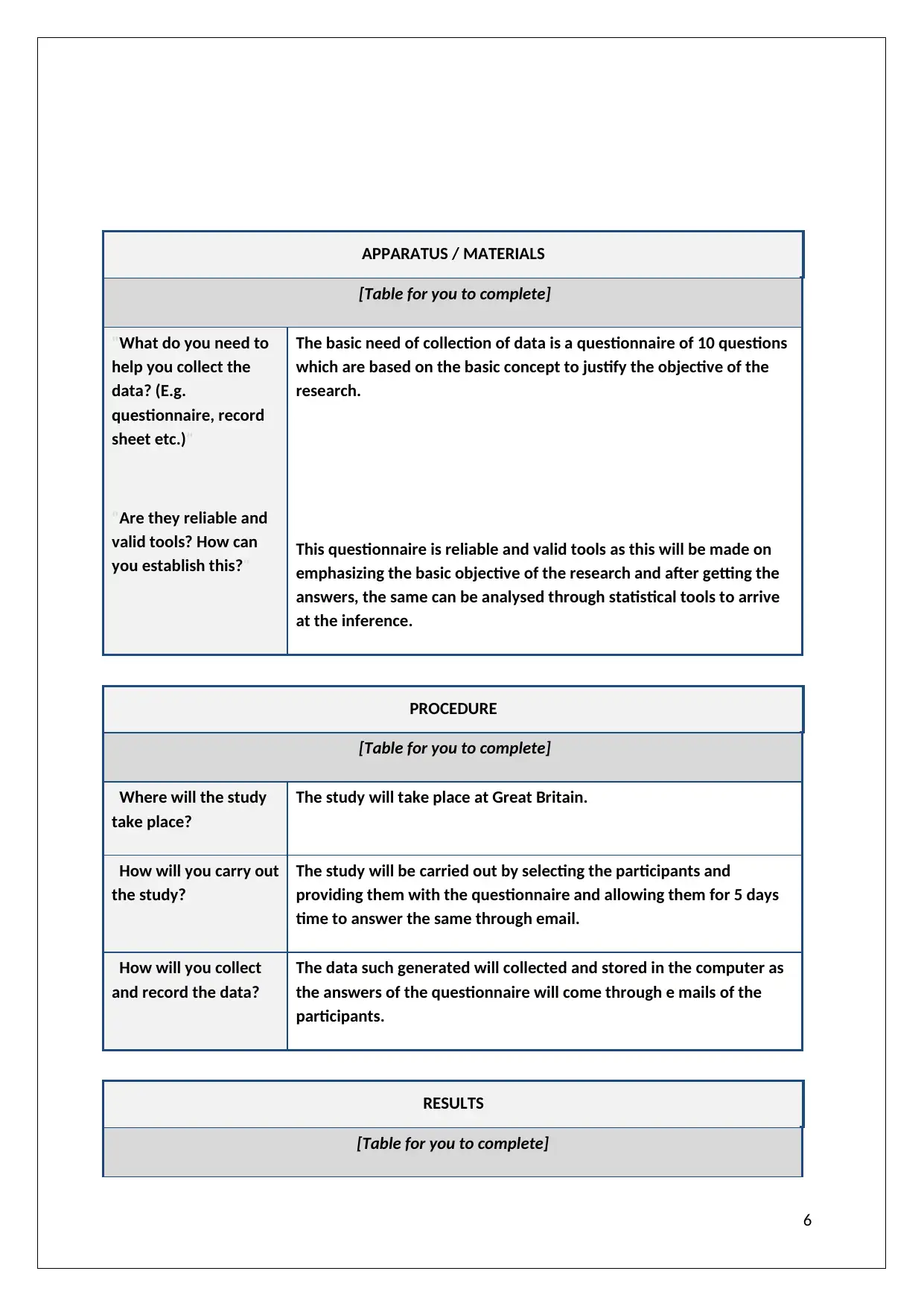
"APPARATUS / MATERIALS"
"[Table for you to complete]"
"What do you need to
help you collect the
data? (E.g.
questionnaire, record
sheet etc.)"
"Are they reliable and
valid tools? How can
you establish this?"
The basic need of collection of data is a questionnaire of 10 questions
which are based on the basic concept to justify the objective of the
research.
This questionnaire is reliable and valid tools as this will be made on
emphasizing the basic objective of the research and after getting the
answers, the same can be analysed through statistical tools to arrive
at the inference.
"PROCEDURE"
" [Table for you to complete]"
"Where will the study
take place?"
The study will take place at Great Britain.
"How will you carry out
the study?"
The study will be carried out by selecting the participants and
providing them with the questionnaire and allowing them for 5 days
time to answer the same through email.
"How will you collect
and record the data?"
The data such generated will collected and stored in the computer as
the answers of the questionnaire will come through e mails of the
participants.
"RESULTS"
"[Table for you to complete]"
6
"[Table for you to complete]"
"What do you need to
help you collect the
data? (E.g.
questionnaire, record
sheet etc.)"
"Are they reliable and
valid tools? How can
you establish this?"
The basic need of collection of data is a questionnaire of 10 questions
which are based on the basic concept to justify the objective of the
research.
This questionnaire is reliable and valid tools as this will be made on
emphasizing the basic objective of the research and after getting the
answers, the same can be analysed through statistical tools to arrive
at the inference.
"PROCEDURE"
" [Table for you to complete]"
"Where will the study
take place?"
The study will take place at Great Britain.
"How will you carry out
the study?"
The study will be carried out by selecting the participants and
providing them with the questionnaire and allowing them for 5 days
time to answer the same through email.
"How will you collect
and record the data?"
The data such generated will collected and stored in the computer as
the answers of the questionnaire will come through e mails of the
participants.
"RESULTS"
"[Table for you to complete]"
6
⊘ This is a preview!⊘
Do you want full access?
Subscribe today to unlock all pages.

Trusted by 1+ million students worldwide
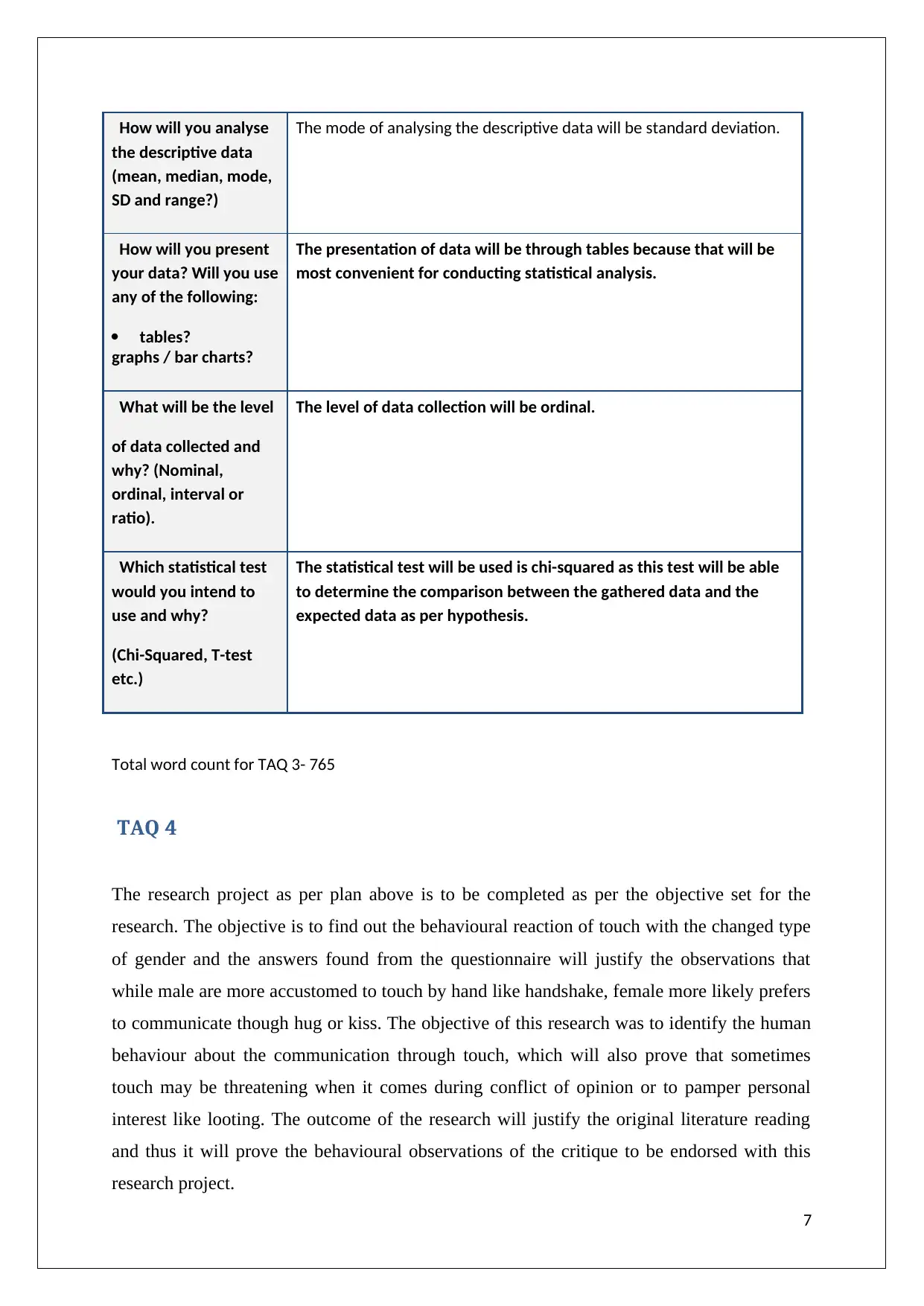
"How will you analyse
the descriptive data
(mean, median, mode,
SD and range?)"
The mode of analysing the descriptive data will be standard deviation.
"How will you present
your data? Will you use
any of the following:
tables?
graphs / bar charts?"
The presentation of data will be through tables because that will be
most convenient for conducting statistical analysis.
"What will be the level
of data collected and
why? (Nominal,
ordinal, interval or
ratio)."
The level of data collection will be ordinal.
"Which statistical test
would you intend to
use and why?
(Chi-Squared, T-test
etc.)"
The statistical test will be used is chi-squared as this test will be able
to determine the comparison between the gathered data and the
expected data as per hypothesis.
Total word count for TAQ 3- 765
TAQ 4
The research project as per plan above is to be completed as per the objective set for the
research. The objective is to find out the behavioural reaction of touch with the changed type
of gender and the answers found from the questionnaire will justify the observations that
while male are more accustomed to touch by hand like handshake, female more likely prefers
to communicate though hug or kiss. The objective of this research was to identify the human
behaviour about the communication through touch, which will also prove that sometimes
touch may be threatening when it comes during conflict of opinion or to pamper personal
interest like looting. The outcome of the research will justify the original literature reading
and thus it will prove the behavioural observations of the critique to be endorsed with this
research project.
7
the descriptive data
(mean, median, mode,
SD and range?)"
The mode of analysing the descriptive data will be standard deviation.
"How will you present
your data? Will you use
any of the following:
tables?
graphs / bar charts?"
The presentation of data will be through tables because that will be
most convenient for conducting statistical analysis.
"What will be the level
of data collected and
why? (Nominal,
ordinal, interval or
ratio)."
The level of data collection will be ordinal.
"Which statistical test
would you intend to
use and why?
(Chi-Squared, T-test
etc.)"
The statistical test will be used is chi-squared as this test will be able
to determine the comparison between the gathered data and the
expected data as per hypothesis.
Total word count for TAQ 3- 765
TAQ 4
The research project as per plan above is to be completed as per the objective set for the
research. The objective is to find out the behavioural reaction of touch with the changed type
of gender and the answers found from the questionnaire will justify the observations that
while male are more accustomed to touch by hand like handshake, female more likely prefers
to communicate though hug or kiss. The objective of this research was to identify the human
behaviour about the communication through touch, which will also prove that sometimes
touch may be threatening when it comes during conflict of opinion or to pamper personal
interest like looting. The outcome of the research will justify the original literature reading
and thus it will prove the behavioural observations of the critique to be endorsed with this
research project.
7
Paraphrase This Document
Need a fresh take? Get an instant paraphrase of this document with our AI Paraphraser
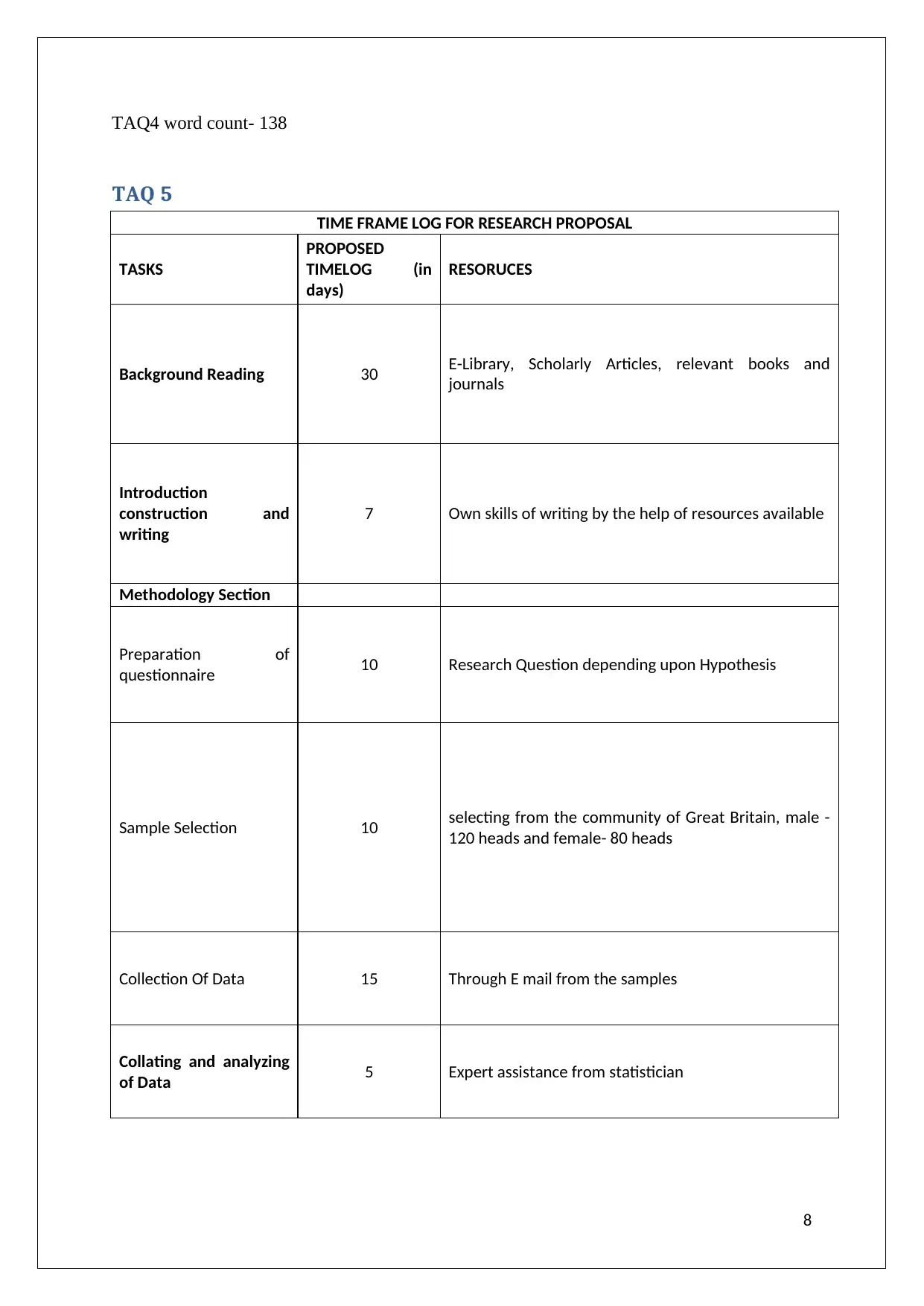
TAQ4 word count- 138
TAQ 5
TIME FRAME LOG FOR RESEARCH PROPOSAL
TASKS
PROPOSED
TIMELOG (in
days)
RESORUCES
Background Reading 30 E-Library, Scholarly Articles, relevant books and
journals
Introduction
construction and
writing
7 Own skills of writing by the help of resources available
Methodology Section
Preparation of
questionnaire 10 Research Question depending upon Hypothesis
Sample Selection 10 selecting from the community of Great Britain, male -
120 heads and female- 80 heads
Collection Of Data 15 Through E mail from the samples
Collating and analyzing
of Data 5 Expert assistance from statistician
8
TAQ 5
TIME FRAME LOG FOR RESEARCH PROPOSAL
TASKS
PROPOSED
TIMELOG (in
days)
RESORUCES
Background Reading 30 E-Library, Scholarly Articles, relevant books and
journals
Introduction
construction and
writing
7 Own skills of writing by the help of resources available
Methodology Section
Preparation of
questionnaire 10 Research Question depending upon Hypothesis
Sample Selection 10 selecting from the community of Great Britain, male -
120 heads and female- 80 heads
Collection Of Data 15 Through E mail from the samples
Collating and analyzing
of Data 5 Expert assistance from statistician
8
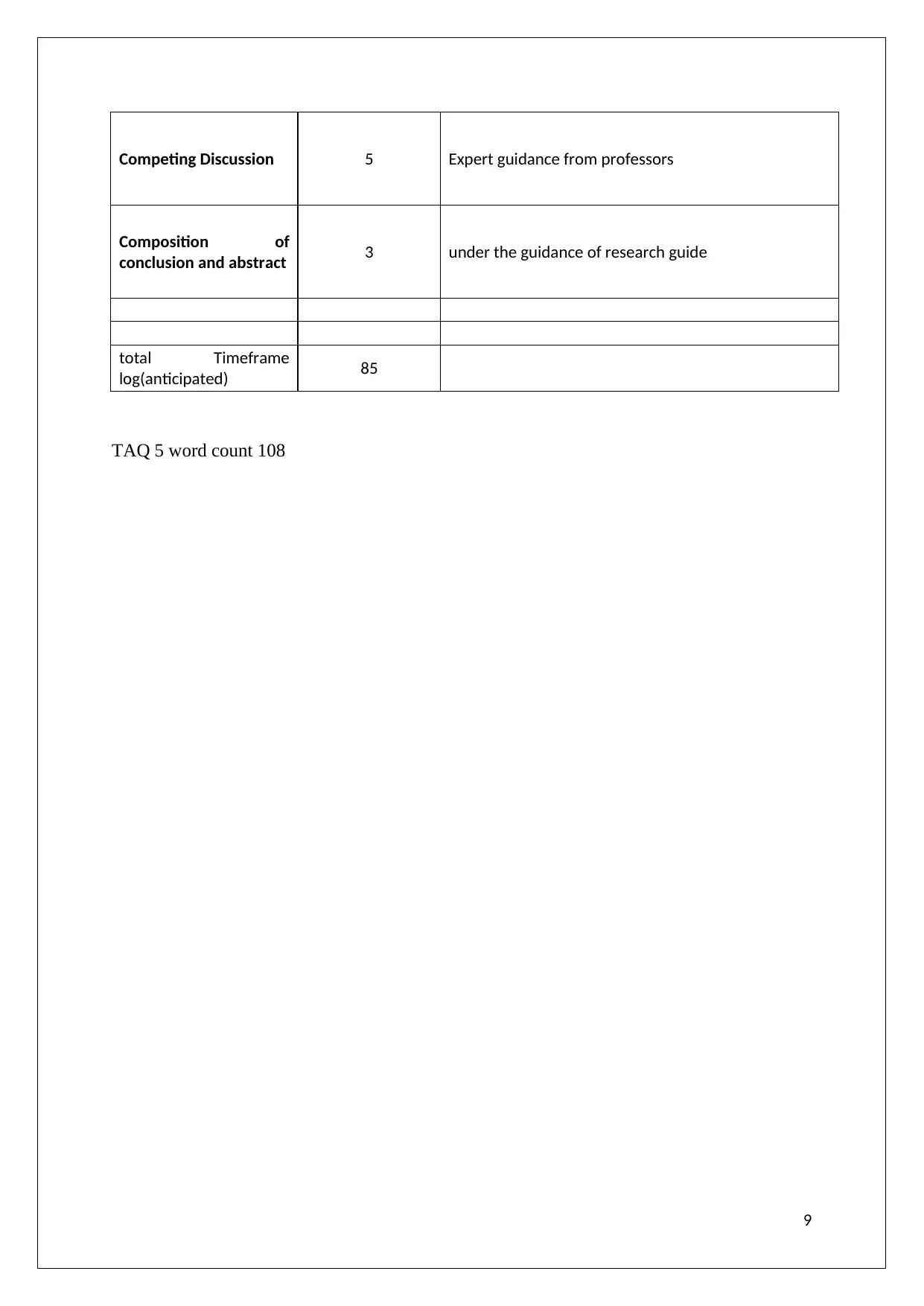
Competing Discussion 5 Expert guidance from professors
Composition of
conclusion and abstract 3 under the guidance of research guide
total Timeframe
log(anticipated) 85
TAQ 5 word count 108
9
Composition of
conclusion and abstract 3 under the guidance of research guide
total Timeframe
log(anticipated) 85
TAQ 5 word count 108
9
⊘ This is a preview!⊘
Do you want full access?
Subscribe today to unlock all pages.

Trusted by 1+ million students worldwide
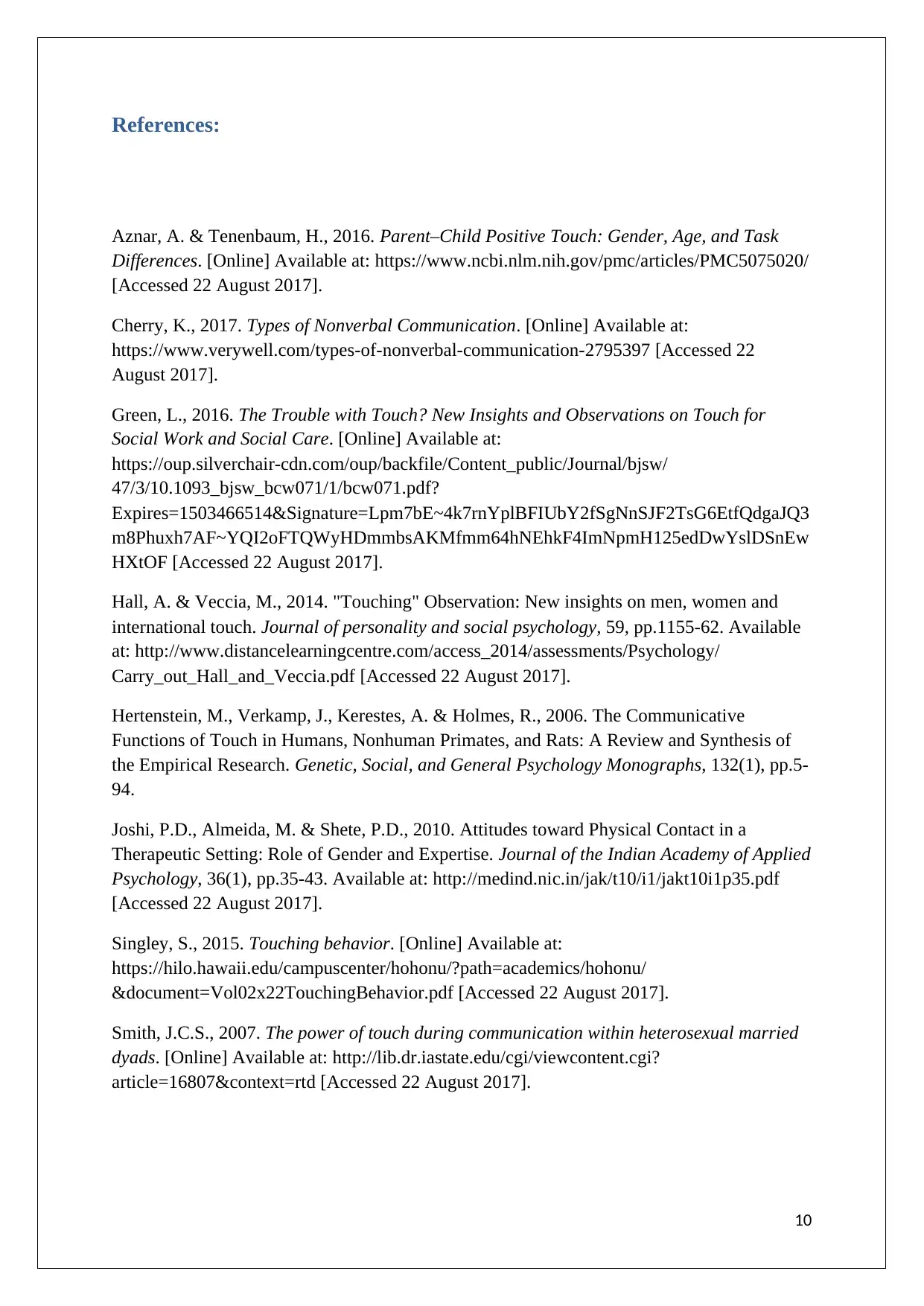
References:
Aznar, A. & Tenenbaum, H., 2016. Parent–Child Positive Touch: Gender, Age, and Task
Differences. [Online] Available at: https://www.ncbi.nlm.nih.gov/pmc/articles/PMC5075020/
[Accessed 22 August 2017].
Cherry, K., 2017. Types of Nonverbal Communication. [Online] Available at:
https://www.verywell.com/types-of-nonverbal-communication-2795397 [Accessed 22
August 2017].
Green, L., 2016. The Trouble with Touch? New Insights and Observations on Touch for
Social Work and Social Care. [Online] Available at:
https://oup.silverchair-cdn.com/oup/backfile/Content_public/Journal/bjsw/
47/3/10.1093_bjsw_bcw071/1/bcw071.pdf?
Expires=1503466514&Signature=Lpm7bE~4k7rnYplBFIUbY2fSgNnSJF2TsG6EtfQdgaJQ3
m8Phuxh7AF~YQI2oFTQWyHDmmbsAKMfmm64hNEhkF4ImNpmH125edDwYslDSnEw
HXtOF [Accessed 22 August 2017].
Hall, A. & Veccia, M., 2014. "Touching" Observation: New insights on men, women and
international touch. Journal of personality and social psychology, 59, pp.1155-62. Available
at: http://www.distancelearningcentre.com/access_2014/assessments/Psychology/
Carry_out_Hall_and_Veccia.pdf [Accessed 22 August 2017].
Hertenstein, M., Verkamp, J., Kerestes, A. & Holmes, R., 2006. The Communicative
Functions of Touch in Humans, Nonhuman Primates, and Rats: A Review and Synthesis of
the Empirical Research. Genetic, Social, and General Psychology Monographs, 132(1), pp.5-
94.
Joshi, P.D., Almeida, M. & Shete, P.D., 2010. Attitudes toward Physical Contact in a
Therapeutic Setting: Role of Gender and Expertise. Journal of the Indian Academy of Applied
Psychology, 36(1), pp.35-43. Available at: http://medind.nic.in/jak/t10/i1/jakt10i1p35.pdf
[Accessed 22 August 2017].
Singley, S., 2015. Touching behavior. [Online] Available at:
https://hilo.hawaii.edu/campuscenter/hohonu/?path=academics/hohonu/
&document=Vol02x22TouchingBehavior.pdf [Accessed 22 August 2017].
Smith, J.C.S., 2007. The power of touch during communication within heterosexual married
dyads. [Online] Available at: http://lib.dr.iastate.edu/cgi/viewcontent.cgi?
article=16807&context=rtd [Accessed 22 August 2017].
10
Aznar, A. & Tenenbaum, H., 2016. Parent–Child Positive Touch: Gender, Age, and Task
Differences. [Online] Available at: https://www.ncbi.nlm.nih.gov/pmc/articles/PMC5075020/
[Accessed 22 August 2017].
Cherry, K., 2017. Types of Nonverbal Communication. [Online] Available at:
https://www.verywell.com/types-of-nonverbal-communication-2795397 [Accessed 22
August 2017].
Green, L., 2016. The Trouble with Touch? New Insights and Observations on Touch for
Social Work and Social Care. [Online] Available at:
https://oup.silverchair-cdn.com/oup/backfile/Content_public/Journal/bjsw/
47/3/10.1093_bjsw_bcw071/1/bcw071.pdf?
Expires=1503466514&Signature=Lpm7bE~4k7rnYplBFIUbY2fSgNnSJF2TsG6EtfQdgaJQ3
m8Phuxh7AF~YQI2oFTQWyHDmmbsAKMfmm64hNEhkF4ImNpmH125edDwYslDSnEw
HXtOF [Accessed 22 August 2017].
Hall, A. & Veccia, M., 2014. "Touching" Observation: New insights on men, women and
international touch. Journal of personality and social psychology, 59, pp.1155-62. Available
at: http://www.distancelearningcentre.com/access_2014/assessments/Psychology/
Carry_out_Hall_and_Veccia.pdf [Accessed 22 August 2017].
Hertenstein, M., Verkamp, J., Kerestes, A. & Holmes, R., 2006. The Communicative
Functions of Touch in Humans, Nonhuman Primates, and Rats: A Review and Synthesis of
the Empirical Research. Genetic, Social, and General Psychology Monographs, 132(1), pp.5-
94.
Joshi, P.D., Almeida, M. & Shete, P.D., 2010. Attitudes toward Physical Contact in a
Therapeutic Setting: Role of Gender and Expertise. Journal of the Indian Academy of Applied
Psychology, 36(1), pp.35-43. Available at: http://medind.nic.in/jak/t10/i1/jakt10i1p35.pdf
[Accessed 22 August 2017].
Singley, S., 2015. Touching behavior. [Online] Available at:
https://hilo.hawaii.edu/campuscenter/hohonu/?path=academics/hohonu/
&document=Vol02x22TouchingBehavior.pdf [Accessed 22 August 2017].
Smith, J.C.S., 2007. The power of touch during communication within heterosexual married
dyads. [Online] Available at: http://lib.dr.iastate.edu/cgi/viewcontent.cgi?
article=16807&context=rtd [Accessed 22 August 2017].
10
Paraphrase This Document
Need a fresh take? Get an instant paraphrase of this document with our AI Paraphraser

11
1 out of 11
Your All-in-One AI-Powered Toolkit for Academic Success.
+13062052269
info@desklib.com
Available 24*7 on WhatsApp / Email
![[object Object]](/_next/static/media/star-bottom.7253800d.svg)
Unlock your academic potential
Copyright © 2020–2025 A2Z Services. All Rights Reserved. Developed and managed by ZUCOL.

